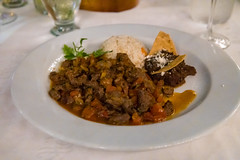While the majority of our Cancún visit was spent either touring around the Hotel Zone or taking excursions out of town (to Puerto Morelos for snorkeling, and Chichén Itzá to see the archaeological site), Cancún also has a lot of great restaurant outside of the Hotel Zone. Our hosts Geoff has been vacationing in Cancún pretty much as long as modern Cancún has been in existence, and he has a favorite restaurant that he always likes to visit over on the mainland in downtown Cancún: La Habichuela (“The String Bean”). On our second night in town, we packed into a cab and headed over to check them out.
Located in what was originally the owner’s home, La Habichuela offers both indoor and outdoor dining, with the latter being in the form of an impressive, expansive grotto located in the backyard, with tables interspersed between sculptures, plants, and strung-up lighting. When the weather is nice, it’s a very pleasant environment to enjoy your dinner and refreshments.
Unlike most of the places we dined in Cancún that focus on a wide variety of cuisines aimed at tourists, La Habichuela focused primarily on Mexican family cuisine, with a little bit of Caribbean added as well (and if you want to focus on “modern Yucatecan”, you can visit their sister restaurant Labna next door), so they’ve got an impressive list of Yucatecan Mexican starters and entrees available. I actually started off with fairly new-to-me dish: sopa de limon (Lime soup). I’m a little surprised that my first sampling of this dish had actually been at the resort the previous day; the version here was exquisite: a nice, really clear but rich chicken soup, with bright lime flavors and just a bit of shredded chicken and tortilla. It’s basically a lighter (but lime-heavy) variant of tortilla soup. While a bit hard to capture in my photo, this was a great start to the meal.
One of the more “old school” restaurant activities that I don’t regularly see anymore is tableside preparation of a classic Caesar salad. It’s somewhat fitting when you get a good one in Mexico, since the salad was invented in Tijuana. La Habichuela does a spectacular job with their version: making up a fresh dressing from oil, eggs, and lemon. Leafing the lettuce and layering it in the bowl. Making up fresh croutons, and tossing it all with a flourish. Yeah, it’s part theater, but it’s also a great way to make a classic salad that’s properly dressed. The end result was one of the better Caesars I’ve had anywhere.
For the main course, I was tempted by the “Cocobichuela”, a house specialty with lobster and shrimp cooked in a curry sauce, served up in a coconut, but I was craving beef, so I had the “Puntas de Filete de Res a la Mexicana” which translates as “Beef Fillet Tips Mexican Style”. This was a very pleasant dish: a generous portion of beef tips that had been simmered in a rich tomato and pepper sauce. The resulting stew-like meal was served with rice and black beans, and this was a very hearty, flavorful, and filling dish.
Carol went for a Mexican classic, the Cochinita Pibil: an achiote-pasted roasted pork, cooked to complete tenderness in a very rich achiote-heavy sauce with some pickled onions and greens. Here, the sauce didn’t bury the pork, which was tender shreds that soaked up the sauce.
Of course, when dessert came around, we decided that this was another good opportunity to continue our trend of getting Café Maya, and La Habichuela’s rendition didn’t disappoint: a pleasant show of the preparation, a heavy application of Xtabentún liquor, and one of the more flavorful ice creams we had (indeed, I’m surprised we didn’t encounter more vanilla in our travels here).
Overall, La Habichuela was one of our more favorite restaurants: the menu was primary “Yucatecan home food done well”, the staff extremely welcoming, and the excellent food all presented with a flourish, and it was a distinctly more relaxed environment than the touristy places over in the hotel zone. I’d definitely make it a point to return here and try several of the other delicious looking dishes, like the Mole Negro or the Cocobichuela.









